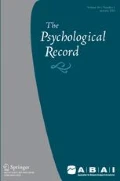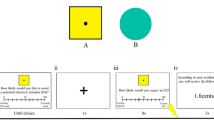Abstract
Introduction
It is well established that stimuli correlated with the absence of aversive events may come to signal periods of safety from those events. In previous research, stimuli that signaled periods of safety were largely neutral in nature. In the present investigation, we examined whether aversive events also could be conditioned as safety signals.
Methods
Seven university students were initially exposed to a 72 dB tone, which all rated as highly aversive. Next, they were required to play a computerized game in which mouse clicks on a map produced points (“treasures”) or point losses (“bombs”). Participants were instructed that bombs could be disabled by pressing a foot pedal, although pedal presses produced the aversive tone. In the next phase of the game, no bombs were programmed. During some sessions, pedal presses produced the tone and in other sessions they did not.
Results
Rates of pedal pressing maintained when the sound was produced; however, pedal pressing eventually ceased in sessions in which it was absent. Follow-up measures indicated that 6 of the 7 participants rated the tone as aversive at the end of the study.
Discussion
These findings suggest that the aversive stimulus functioned as a positive reinforcer, given that participants chose to produce the sound even when it did not abate aversive stimulation.




Similar content being viewed by others
References
Azrin, N. H., & Holz, W. C. (1966). Punishment. In W. K. Honig (Ed.), Operant behavior: Areas of research and application (pp. 380–447). New York: Appleton-Century- Crofts.
Bizo, L. A., Remington, B., D’Souza, L. S., Heighway, S. K., & Baston, C. (2002). Human variable ratio performance. Learning and Motivation, 33, 411–432.
Burchardt, C. J., & Levis, D. J. (1977). Utility of presenting slides of a phobic stimulus in context of a behavioral avoidance procedure. Behavior Therapy, 8, 340–346.
Candido, A., Gonzalez, F., & de Brugada, I. (2004). Safety signals from avoidance learning but not from yoked classical conditioning training pass both summation and retardation tests for inhibition. Behavioural Processes, 66, 153–160.
Ciminero, A. R., & Davidson, R. S. (1977). Free-operant avoidance of alcohol: Analog study of alcohol aversion. Journal of Behavior Therapy and Experimental Psychiatry, 8, 371–376.
Delgado, M. R., Jou, R. L., LeDoux, J. E., & Phelps, E. A. (2009). Avoiding negative outcomes: Tracking the mechanisms of avoidance learning in humans during fear conditioning. Frontiers in Behavioural Neuroscience, 3, 1–9.
Dinsmoor, J. A. (1954). Punishment: I. The avoidance hypothesis. Psychological Review, 61, 34–46.
Dinsmoor, J. A. (1977). Escape, avoidance, punishment: Where do we stand? Journal of the Experimental Analysis of Behavior, 28, 83–95.
Dinsmoor, J. A. (2001a). Still no evidence for temporally extended shock-frequency reduction as a reinforcer. Journal of the Experimental Analysis of Behavior, 75, 367–378.
Dinsmoor, J. A. (2001b). Stimuli inevitably generated by behavior that avoids electric shock are inherently reinforcing. Journal of the Experimental Analysis of Behavior, 75, 311–333.
Dinsmoor, J. A., & Sears, G. W. (1973). Control of avoidance by a response-produced stimulus. Learning and Motivation, 4, 284–293.
Emmelkamp, P. M., Kraaijkamp, H. J., & van den Hout, M. A. (1999). Assessment of obsessive–compulsive disorder. Behavior Modification, 23, 269–279.
Fernando, A., Urcelay, G., Mar, A., Dickinson, A., & Robbins, T. (2014). Free-operant avoidance behaviour by rats after reinforcer revaluation using opioid agonists and D amphetamine. Journal of Neuroscience, 34, 6286–6293.
Foa, E. B., Huppert, J. D., Leiberg, S., Langner, R., Kichic, R., Hajcak, G., & Salkovskis, P. M. (2002). The obsessive-compulsive inventory: Development and validation of a short version. Psychological Assessment, 14, 485–496.
Fullana, M. A., Tortella-Feliu, M., Caseras, X., Andion, O., Torrubia, R., & Mataix-Cols, D. (2005). Psychometric properties of the Spanish version of the obsessive-compulsive inventory–revised in a non-clinical sample. Journal of Anxiety Disorders, 19, 893–903.
Galizio, M. (1979). Contingency-shaped and rule-governed behavior: Instructional control of human loss avoidance. Journal of Experimental Analysis of Behavior, 31, 53–70.
Hajcak, G., Huppert, J. D., Simons, R. F., & Foa, E. B. (2004). Psychometric properties of the OCI-R in a college sample. Behaviour Research and Therapy, 42, 115–123.
Hodgson, R. J., & Rachman, S. (1977). Obsessional-compulsive complaints. Behaviour Research and Therapy, 15, 389–395.
Joiner, T. E., & Metalsky, G. I. (2001). Excessive reassurance seeking: Delineating a risk factor involved in the development of depressive symptoms. Psychological Science, 12, 371–378.
Kim, H., Shimojo, S., & O’Doherty, P. J. (2006). Is avoiding an aversive outcome rewarding? Neural substrates of avoidance learning in the human brain. PLoS Biology, 4, 1453–1461.
Lerman, D. C., & Iwata, B. A. (1996). Developing a technology for the use of operant extinction in clinical settings: An examination of basic and applied research. Journal of Applied Behavior Analysis, 29, 345–385.
Mowrer, O. H. (1951). Two-factor learning theory: Summary and comment. Psychological Review, 58, 350–354.
Rachman, S. (1998). A cognitive theory of obsessions. Behaviour Research and Therapy, 36, 385–401.
Rescorla, R. A. (1969). Establishment of a positive reinforcer through contrast with shock. Journal of Comparative and Physiological Psychology, 67, 260–263.
Salkovskis, P. M. (1991). The importance of behaviour in the maintenance of anxiety and panic: A cognitive account. Behavioural Psychotherapy, Special Issue: The Changing Face of Behavioural Psychotherapy, 19, 6–19.
Schoenfeld, W. N. (1950). An experimental approach to anxiety, escape, and avoidance. In P. H. Hoch & J. Zubi (Eds.), Anxiety (pp. 70–99). New York: Grune & Stratton.
Sidman, M. (1989). Avoidance at Columbia. Behavior Analyst, 12, 191–195.
Siegel, P., & Weinberger, J. (2009). Very brief exposure: The effects of unrepeatable stimuli on fearful behavior. Consciousness and Cognition, 18, 939–951.
Sternberger, L. G., & Burns, G. L. (1990). Compulsive activity checklist and the Maudsley obsessional-compulsive inventory: Psychometric properties of two measures of obsessive-compulsive disorder. Behavior Therapy, 21, 117–127.
Taffou, M., Guerchouche, R., Drettakis, G., & Viaud-Delmon, I. (2013). Auditory-visual aversive stimuli modulate the conscious experience of fear. Multisensory Research, 26, 347–370.
Unger, W., Evans, I. M., Rourke, P., & Levis, D. J. (2003). The S-S construct of expectancy versus S-R construct of fear: Which motivates the acquisition of avoidance behavior? Journal of General Psychology, 2, 131–147.
Acknowledgments
The authors thank Matilda Angelaki for her helpful comments on the manuscript.
Author information
Authors and Affiliations
Corresponding author
Rights and permissions
About this article
Cite this article
Angelakis, I., Austin, J.L. Aversive Events as Positive Reinforcers: An Investigation of Avoidance and Safety Signals in Humans. Psychol Rec 65, 627–635 (2015). https://doi.org/10.1007/s40732-015-0133-4
Published:
Issue Date:
DOI: https://doi.org/10.1007/s40732-015-0133-4




